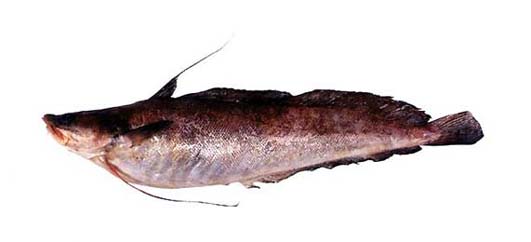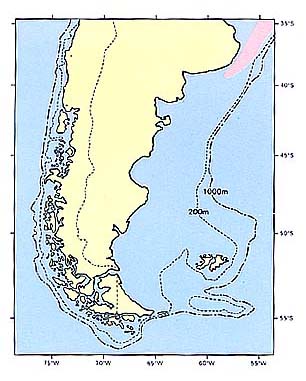タラ科
タラ科(Gadidae)

31 ミナミアシナガダラ(Minami-ashinagadara)
Urophysis brasiliensis (Kaup, 1858)
Brótola, Brótula (Arg., Urg.); Abrótea (Br.)
特 徴:
第1背鰭9〜10軟条,第2背鰭53〜59軟条,臀鰭43〜46軟条,胸鰭17〜18軟条,腹鰭2軟条,側線鱗数133〜135軟条,鰓耙数14〜15軟条,体長に対する体高の割合は21.2〜23.5%,頭長は24.1〜25.3%,眼径は2.0〜3.2%,両眼間隔は5.3〜5.6%,吻長は7.1〜7.2%,上顎長は11.2〜11.8%。尾柄高は4.9〜5.5%,胸鰭長は12.4〜14.4%,腹鰭長は39.8〜45.7%,第1背鰭第2鰭条長は30.2〜33.5%,髭長は2.8〜3.1%,背鰭前長は25.3〜27.1%,臀鰭前長は49.3〜50.3%,背鰭基底長は5.9〜6.3%,第2背鰭基底長は62.9〜65.6%,臀鰭基底長は47.0〜48.6%。体は延長し,側扁するが,頭部はやや縦扁する。第1背鰭第2鰭条は著しく延長し,第2背鰭のほぼ中央に達する。両背鰭は著しく接近する。第2背鰭および臀鰭の後端はその先端が丸い。胸鰭は短く扇状,腹鰭は2本の鰭条からなり,内側のものは糸状に延長し,臀鰭前方1/3に達する。臀鰭後縁は丸い。両眼間隔域は幅広く盛り上がる。眼は小さい。吻は突出し,下顎は上顎下に含まれる。下顎先端に短い髭がある。上顎の後端は眼の後縁下を越える。両顎歯は小さな絨毛状歯で歯帯を形成する。鋤骨にも小歯があるが,口蓋骨に歯はない。尾柄は高く短い。鱗は小さな薄い円鱗。体の背方は茶褐色で,腹方は淡褐色。各鰭の縁辺は黒味をおびる。
分 布:
南米大西洋岸のブラジル南部からアルゼンチン北部(35°〜40°S)の水深約40〜50m付近に分布する。
備 考:
Svetovidov(1948)によれば本種の臀鰭鰭条数は48〜58となっており,本標本の測定値とかなり異なる。近縁のU. mystaceusがリオデジャネイロからアルゼンチン北部にかけ分布するが,第1背鰭は糸状に延長しない(Figueiredo and Menezes, 1978)。
(稲田伊史)
Material examined:
3 from Argentina (345-369 mm SL), FSFL EM 44, 45, 226.Description:HL 24.1-25.3 % of SL; ED 2.0-3.2; BD 21.2-23.5; SN 7.1-7.2; IO 5.3-5.6; UJ 11.2-11.8; CP 4.9-5.5; P1L 12.4-14.4; P2L 39.8-45.7; D1 2nd ray L 30.2-33.5; Barbel L 2.8-3.1; PreD 25.3-27.1; PreA 49.3-50.3; D1 base L 5.9-6.3; D2 base L 62.9-65.6; A base L 47.0-48.6.
Body elongate and compressed, head rather depressed. Second ray of first dorsal fin considerably elongate, reaching middle ray of 2nd dorsal. Both dorsal fins extremely close together. Posterior ends of second dorsal and anal fins slightly rounded at tip. Pectoral fin short and fan-shaped. Pelvic fin composed of two long filamentous rays, its inner ray greatly elongate and reaching anterior one-third of anal fin. Posterior margin of caudal fin rounded. Interorbital space wide and convex. Eye small. Snout protruded. Lower jaw included under upper; barbel short, situated at tip of lower jaw. End of upper jaw reaching beyond level of posterior margin of eye. Teeth on both jaws villiform, in bands. Vomerine teeth present, palatines edentate. Caudal peduncle short and deep. Scales small, thin, cycloid. Upper part of body brownish, belly pale brown. Tip of each fin blackish.
Distribution:
Atlantic coast of South America, from southern Brazil to northern Argentina (35°-40°S) at depths of about 45-50 m.
Remarks:
According to Svetovidov (1948), U. brasiliensis has 48 to 58 anal fin rays, and thus differs from the specimens examined here. A closely related species, U. mystaceus is recorded from Rio de Janeiro to northern Argentina, but does not have an elongate dorsal fin ray.
(Tadashi INADA)

Distribution of Urophysis brasiliensis in Patagonia.
- 1
- 2